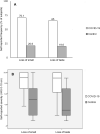Chemosensory dysfunction in COVID-19 out-patients
- PMID: 32844305
- PMCID: PMC7447084
- DOI: 10.1007/s00405-020-06266-3
Chemosensory dysfunction in COVID-19 out-patients
Abstract
Background: Since the outbreak in China due to coronavirus disease 2019 (COVID-19) various studies have been published describing olfactory and gustatory dysfunction (OGD).
Objective: The aim was to investigate the frequency and severity of OGD in SARS-CoV-2 (+) out-patients compared to controls with common cold/flu like symptoms and two negative RT-PCR.
Methods: A multicenter cross-sectional study on SARS-CoV-2-positive out-patients (n = 197) and controls (n = 107) from five Spanish Hospitals. Severity of OGD was categorized by visual analogue scale (VAS). Frequency and severity of the chemosensory impairment were analyzed.
Results: The frequencies of smell (70.1%) and taste loss (65%) were significantly higher among COVID-19 subjects than in the controls (20.6% and 19.6%, respectively). Simultaneous OGD was more frequent in the COVID-19 group (61.9% vs 10.3%) and they scored higher in VAS for severity of OGD than controls. In the COVID-19 group, OGD was predominant in young subjects 46.5 ± 14.5 and females (63.5%). Subjects with severe loss of smell were younger (42.7 years old vs 45.5 years old), and recovered later (median = 7, IQR = 5.5 vs median = 4, IQR = 3) than those with mild loss of smell. Subjects with severe loss of taste, recovered later in days (median = 7, IQR = 6 vs median = 2, IQR = 2), compared to those with mild loss.
Conclusion: OGD is a prevalent symptom in COVID-19 subjects with significant differences compared to controls. It was predominant in young and females subjects. Stratified analysis by the severity of OGD showed that more than 60% of COVID-19 subjects presented a severe OGD who took a longer time to recover compared to those with mild symptoms.
Keywords: Ageusia; Anosmia; COVID-19; Hyposmia; Out-patients; SARS-CoV-2; Taste loss.
Conflict of interest statement
Isam Alobid: Consultant for Roche, Novartis, Mylan, Menarini, MSD. Joaquim Mullol: member of national or international advisory boards, received speaker fees, or funding for clinical trials and research projects from ALK, AstraZeneca, Genentech, GlaxoSmithKline, Glenmark, Menarini, Mitsubishi-Tanabe, MSD, Mylan-MEDA Pharma, Novartis, Regeneron Pharmaceuticals, SANOFI-Genzyme, UCB Pharma, and Uriach Group. The other authors declare that they have no conflicts of interest.
Figures
References
-
- Coronavirus disease 2019 (COVID-19): situation report-118. Geneva: World Health Organization reports. https://www.who.int/emergencies/diseases/novel-coronavirus-2019/situatio.... Accessed 28 May 2020
-
- Vukkadala N, Qian ZJ, Holsinger FC, Patel ZM, Rosenthal E (2020) COVID- 19 and the otolaryngologist - preliminary evidence-based review. Laryngoscope. 10.1002/lary.28672 (Epub ahead of print) - PubMed
-
- Wu Z, McGoogan JM (2020) Characteristics of and important lessons from the coronavirus disease 2019 (COVID-19) outbreak in China: summary of a report of 72314 cases from the Chinese center for disease control and prevention. JAMA 10.1001/jama.2020.2648. (Epub ahead of print) - PubMed
-
- Zhang J, Wu S, Xu L (2020) Asymptomatic carriers of COVID-19 as a concern for disease prevention and control: more testing, more follow- up. Biosci Trends. 10.5582/bst.2020.03069. (Epub ahead of print) - PubMed
MeSH terms
LinkOut - more resources
Full Text Sources
Medical
Miscellaneous


